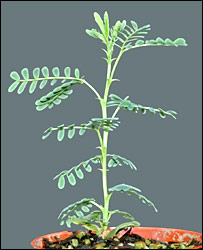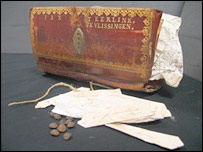 Seeds which have been stored away since the time of George III have been persuaded into new life. Scientists from the Millennium Seed Bank, operated by the Royal Botanic Gardens at Kew, have induced seeds from three species to germinate.
Seeds which have been stored away since the time of George III have been persuaded into new life. Scientists from the Millennium Seed Bank, operated by the Royal Botanic Gardens at Kew, have induced seeds from three species to germinate.They had been brought to Britain from South Africa by a Dutch merchant in 1803, and were found in a notebook stored in the National Archives.
Given this history, the team said it was surprised by their success. "They had been kept under pretty poor conditions," said Matt Daws, a seed ecologist with the Millennium Seed Bank, which is located at Wakehurst Place in West Sussex. They'd been in a ship for a year, certainly for months, coming back from the Cape; then they'd been kept in the Tower of London for a number of years. Only in the last 10 years have they been in controlled conditions. So I didn't expect any of them to germinate," he told the BBC News website, "and the three that did really are tough seeds."
The three successes are a legume, Liparia villosa, and two species not yet identified, one a protea and the other an acacia. The Liparia did particularly well, with 16 out of the 25 seeds progressing into plants.
The acacia was a different proposition. "We only had two seeds to work with, and one of them turned out to have been eaten inside by an insect," recalled Dr Daws. "What that means is we didn't have many options - it was a shot in the dark as to whether we'd be able to get things to work."
The Cape region is regularly visited by fire, which is a signal to germinate. So scientists mimicked the effects of fire by chipping off the hard coats of some seeds, and bubbling smoke over others. Even with this detailed preparation, 29 of the 32 species represented declined to germinate.
These are not the oldest seeds ever tempted into life. Four years ago scientists in the US germinated lotus seeds which had been carbon-dated as 500 years old; more recently, an Israeli team claimed to have grown a date palm from a 2,000 year old seed.
They were originally taken on board the Prussian ship Henriette by Jan Teerlin
 k, a merchant bringing silk and tea from Java and China, as the ship stopped off at the Cape of Good Hope on its way back to Europe.
k, a merchant bringing silk and tea from Java and China, as the ship stopped off at the Cape of Good Hope on its way back to Europe.On the way back the Henriette was captured by the British navy; and Teerlink's possessions, including his notebook, passed to the High Court of Admiralty, and then to the Tower. Why he carried the seeds and why he put them between the pages of his notebook are unknown.
When the plants are older, the Kew scientists plan to make genetic and genomic analyses, and compare the old plants with modern-day equivalents, perhaps showing how Cape species have changed and adapted over the last two centuries.
No comments:
Post a Comment